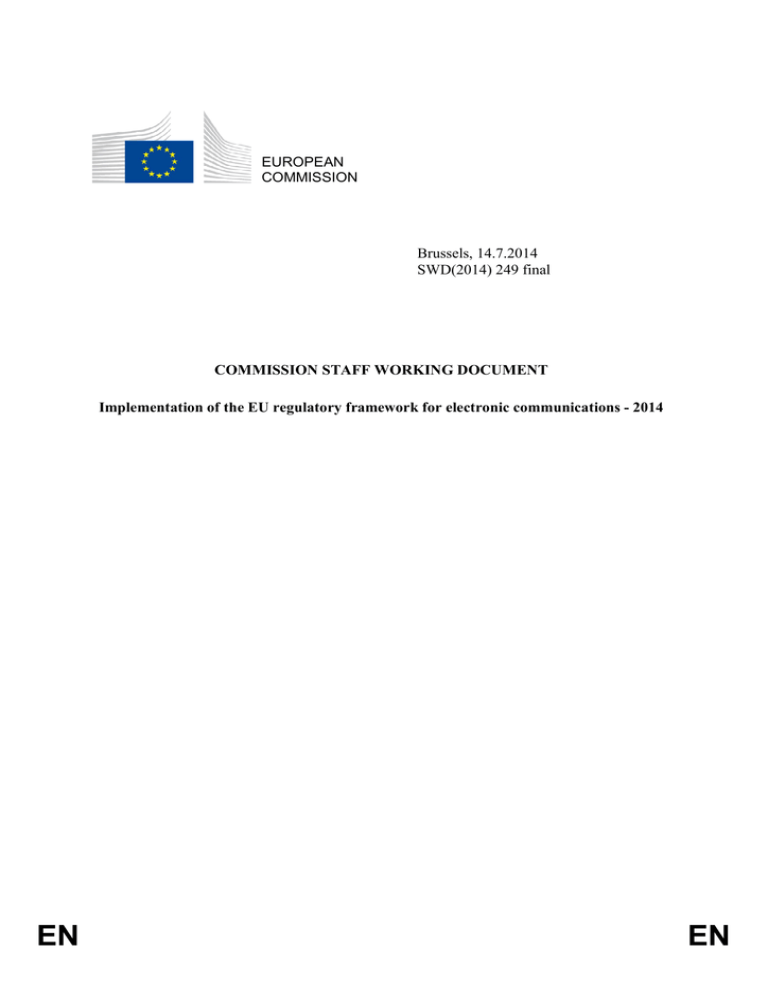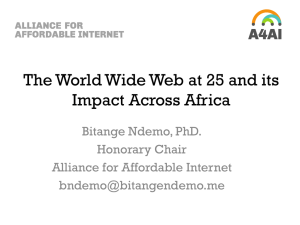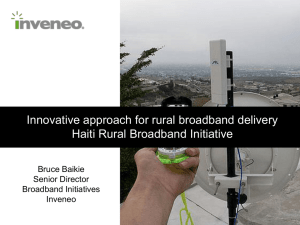2014 EU Report - European Commission
advertisement

EUROPEAN COMMISSION Brussels, 14.7.2014 SWD(2014) 249 final COMMISSION STAFF WORKING DOCUMENT Implementation of the EU regulatory framework for electronic communications - 2014 EN EN 2 Table of Contents 1. Digital Agenda Targets and Economic Indicators ....................................................... 3 2. Competitiveness in the Sector...................................................................................... 5 2.1. International Comparison of the Mobile Market ......................................................... 6 3. Market Developments .................................................................................................. 7 4. Market Regulation...................................................................................................... 10 5. Broadband Plans and Financing................................................................................. 11 6. Institutional Issues...................................................................................................... 12 6.1. National Regulatory Authorities ................................................................................ 12 6.2. Authorisation.............................................................................................................. 12 7. Spectrum management ............................................................................................... 13 8. Rights of way and access to passive infrastructure.................................................... 15 9. Access and interconnection........................................................................................ 15 10. Consumer issues......................................................................................................... 16 11. Universal Service ....................................................................................................... 17 12. Net Neutrality............................................................................................................. 18 12.1. Legislative situation ................................................................................................... 18 12.2. Quality of service ....................................................................................................... 19 Implementation of the EU regulatory framework for electronic communications - 2014 INTRODUCTION In May 2010, the European Commission adopted the Digital Agenda for Europe (DAE)1, a strategy to take advantage of the potential offered by the rapid progress of digital technologies. The DAE is part of the overall Europe2020 strategy for smart, sustainable and inclusive growth. The Digital Agenda contains 13 specific goals2 which encapsulate the digital transformation which the Commission wants to achieve. Progress against these targets is measured in the annual Digital Agenda Scoreboard.3 The 2014 Digital Agenda Scoreboard assesses progress at EU and national level in achieving this goal, as measured against the 13 key performance indicators. The report is based on 2013 data. In connection with the Digital Agenda Scoreboard the Commission publishes annually a Staff Working Document describing the situation of the single European electronic communications market and the status of the implementation of the EU regulatory framework for electronic communications in the EU.4 The present Staff Working Document addresses a set of key regulatory areas and its respective indicators which should enable an overall assessment at EU level and a countryby-country comparison and benchmarking of the status of implementation of the ecommunications regulatory framework in areas which are linked to DG CONNECT's core policy objectives and key initiatives. A. MARKET 1. DIGITAL AGENDA TARGETS AND ECONOMIC INDICATORS Broadband Indicators (January 2014)5 Speed Member States Growth7 Range6 (%) Range (%) Basic 75 – 100 0–8 Fixed broadband 8 9 coverage NGA 21 – 100 0 – 75 Fixed broadband From 144 Kbps 19 – 41 2–9 10 penetration From 30 Mbps 0,1 – 23 9 – 840 1 EU Average % 97 62 30 6,3 Growth (%) 2 15 4 47 http://ec.europa.eu/digital-agenda/digital-agenda-europe. E.g. to name just a few: the entire EU to be covered by broadband by 2013, the entire EU to be covered by broadband above 30 Mbps by 2020, 50 % of the EU to subscribe to broadband above100 Mbps by 2020 (for a complete list see http://ec.europa.eu/digital-agenda/en/digital-agenda-scoreboard). 3 https://ec.europa.eu/digital-agenda/en/scoreboard. 4 https://ec.europa.eu/digital-agenda/en/download-scoreboard-reports. 5 Source: coverage: IHS and VVA for 2013 and Point Topic for 2012; penetration: COCOM, 2014. 6 Lowest and highest figures in the Member States. 7 Increase over the figure of a year earlier, expressed as a percentage. 8 Availability of network for those who want to subscribe. See also the Glossary. Coverage data is from December 2013. 9 Includes FttH, FttB, FttO, VDSL, Cable with Docsis 3. See also the Glossary. 10 Subscribed lines per 100 inhabitants. See also the Glossary. 2 4 From 100 Mbps 11 Mobile broadband Basic (HSPA ) coverage LTE Mobile broadband penetration 0 – 10 86 – 100 0 – 99 26 – 124 0 – 1400 0 – 15 0 – 13800 -23 – 31 1,6 97 59 61 78 1 125 5 The Digital Agenda for Europe sets the ambitious targets that, by 2020, all EU households should have access to at least 30 Mbps and that 50 % of subscriptions should be at least 100 Mbps. Basic broadband coverage is now 100%, and is ensured via different technologies (fixed, wireless, mobile and satellite). High speed broadband penetration is still low, but in many Member States is growing rapidly. Some Member States are trailing with very low fixed high speed broadband coverage and penetration rates.12 Fixed Broadband Penetration, January 2014 – Countries in order of advertised downstream speed of 100 Mbps 100+ Mbps 30 - 100 Mbps LTE Coverage, December 2013 11 12 See the Glossary. Italy, Greece. 144 Kpbs - 30 Mbps Source: COCOM, 2014 Source: IHS and VVA, May 2014 5 2. COMPETITIVENESS IN THE SECTOR Revenues and investment in the electronic communications sector13 2010 2011 Revenues € 327,3 billion €334,7 billion Increase N/A 2,2% Investment € 38,8 billion €41,5 billion Increase N/A 6,9% 2012 €323,6 billion -3,3% €42,1 billion 1,4% The 2012 decline in revenues in the European electronic communications sector contrasts with the trends in other parts of the world, where there was a growth in revenues. The USA experienced a growth in revenues of 5,1%, Japan of 0,11% and the global growth was 4,2% in 2012.14 Telecom revenue growth, 2011-2012 Source: COCOM, 2014 In spite of a reported decrease of revenues at EU level and a negative context of economic downturn in several Member States, investment in the sector at EU level has experienced growth in 2012 compared to the previous year, but with significant variations across countries. 13 Source: COCOM. The investment figures do not include fees for the acquisition of rights of use of radio frequencies. 14 European Information Technology Observatory (EITO) 2012/13. 6 Telecom investment growth, 2011-2012 2.1. 15 Source: COCOM, 2014 International Comparison of the Mobile Market Over the last decade, mobile revenue has been growing steadily in the USA, whereas it has been wavering in the EU. Mobile Revenue in the EU and the USA in billion euro, 2005-20012 Source: Bloomberg, 2014 In the same timespan, the average revenue per user (ARPU) has very gradually increased in the USA and appreciably declined in the EU. Monthly Wireless ARPU in the EU and the USA, 2005-2012 15 Source: GSMA, 2013 The underlying investment data do not include fees for the acquisition of rights of use of radio frequencies. 7 The underlying dynamics reflect either different market strategies or different stages in similar business models in the EU and the USA. The prices per unit are higher in the EU, but consumption is much higher in the USA, resulting in higher revenue per subscription in the USA. The Mobile Market in the EU and the USA, 2012 Average Voice Revenue per Minute (€) 3. Monthly Voice Use per Subscription (Minutes) Source: GSMA, 2013 Data Traffic per Connection (MB) Monthly Revenue per Subscription (€) MARKET DEVELOPMENTS The fixed broadband market continues to grow steadily, with new entrants gaining more new customers than the incumbents. Large differences persist among Member States as regards the number of alternative providers, the technology they use, and their total market share. Fixed broadband lines – new entrants' market share, January 2013 – January 2014 Source: COCOM, 2014 While the share of DSL subscriptions is shrinking, it remains the dominant broadband technology. Full local loop unbundling remains also the most widely used way to enter the market as alternative operator. The shares of cable and of FttB/FttH connections are constantly increasing. 8 NGA subscriptions as a % total fixed broadband subscriptions, January 2014 Source: COCOM, 2014 The fixed voice market continues its overall decline due to increasing fixed to mobile replacement and VoIP alternatives. The market shares of the incumbents of remaining fixed calls are also continuing to decline, though in certain countries at a very slow pace. Incumbents' market share – all fixed calls by traffic volume, 2011-2012 Source: COCOM, 2014 Revenues on the mobile market have continued to decrease. A boom in data traffic is helping to some extent to counteract this trend, but also requires investment in network upgrades and roll-out, and goes alongside a trend of a reduction of the average price per MB of data. Mobile penetration continued to increase, while the ARPU continued to decrease, to € 187 p.a. in 2012, down from € 195 a year before. Nevertheless, this segment remains the most profitable one in the electronic communications market. The dynamics of the mobile market have remained fairly stable, with the average shares of the three main operators ranging between 25% and 35%. While in some smaller Member States there are higher levels of concentration, in other Member States the number of mobile operators has increased from 3 to 4 main players, increasing thereby the price pressure. 9 Mobile subscribers: operator market shares, October 2013 Leading operator Main competitor 16 Source: COCOM, 2014 Other operators Data roaming rates within the EU have remained below the applicable retail price cap. Average retail roaming data price per Mb (prepaid + postpaid) Q3 2013 BEREC, 2013 Source Data price cap (0,50 €) Several consolidations have taken place, including a number of fixed-mobile transactions, in order to respond to higher levels of competition, decreasing revenues from traditional sources and to the increasing need to invest in data capacity. Moreover, bundled offers are gaining popularity throughout the EU, though at very different paces. In several Member States, a majority of households take triple or quad-play subscriptions. In terms of market dynamics, triple and quad-play are said to reduce churn. They also drive alliances across the fixed and mobile segments of the market, as operators are under pressure to become quad-play providers. 16 Data not available for Belgium, Greece, Germany, Netherlands, United Kingdom. 10 B. POLICY AND REGULATION 4. MARKET REGULATION The Member States have aligned their regulatory actions with the Commission Recommendation on Termination Rates17 to a varying degree. The implementation of the Recommendation with respect to fixed termination is lagging behind that of mobile termination. Whilst most regulators have imposed the recommended costing methodology based on a pure bottom-up LRIC approach, for both mobile and fixed termination rates, certain Member States still use other methods such as LRIC+18 or Fully Allocated Costs.19 In the case of Germany, the NRA chose not to follow several Article 7a Recommendations by the Commission and guidance from the Body of European Regulators for Electronic Communications (BEREC), without providing satisfactory reasons as to the justification for its decision. As this dissonance in implementation proves detrimental to the internal market and in order to ensure a consistent application of the Framework on appropriate and proportionate price-control remedies, the Commission services are following up on these issues with Member States. Some regulators have used benchmarking on the basis of prices applied in Member States where a BU-LRIC model has been applied20 until the completion of their own pure LRIC model. Regulation of the market for wholesale SMS termination remains an exception.21 A large number of the most recently notified draft measures concerning the markets for wholesale (physical) network infrastructure access and wholesale broadband access took account of the Commission Recommendation on consistent non-discrimination obligations and costing methodologies of September 2013.22 In addition, it is expected that the forthcoming notifications (e.g. from the Netherlands, France and Sweden) will also follow the approach set out in the 2013 Recommendation. However, also in this field, some NRAs chose not to follow relevant Article 7a Recommendations.23 In order to ensure a consistent application of the Framework on appropriate and proportionate price-control remedies, the Commission services are following up on these issues with these Member States. An increasing number of SMP operators are now required to provide virtual unbundling (e.g. in the United Kingdom, Austria, Malta and Denmark). However, in many Member States fibre infrastructure unbundling is not yet regulated (e.g. Luxemburg, Latvia) and the Commission invited regulators in a number of those countries (e.g. Cyprus, France) to consider adopting measures concerning access to fibre infrastructure. Access to the incumbent’s civil engineering is mandated in large number of Member States. The use of vectoring technology leads an increasing number of regulators to re-consider the use of physical unbundling obligations. For example, in Germany and Belgium SMP operators (and also alternative operators in the case of Germany) that employ vectoring are obliged to offer an appropriate virtual substitute solution instead of physical unbundling in order to ensure a similar 17 Commission Recommendation C(2009) 3359 of 7.5.2009. E.g. Germany, Lithuania; in the Netherlands it was imposed by a court order. 19 Finland. 20 Luxemburg, Latvia, Portugal, Ireland, Romania. 21 France, Denmark, Poland. 22 Commission Recommendation C(2013) 5761 of 11.9.2013. 23 Austria, Estonia. 18 11 functionality of the lines affected by vectoring. However, a common approach to such new forms of wholesale access products is missing. Regulators in several Member States24 continued the trend towards lifting ex ante regulation of certain markets, notably wholesale markets for access and call origination on public mobile and fixed telephone networks and retail markets for publicly available telephone services, given the tendency towards effective competition. Difficulties to respect the statutory timeframes for reviews was a concern in several Member States, in particular in Italy with regard to several regulated markets, Belgium in relation to the market for wholesale terminating segments of leased lines and in Cyprus in relation to the market for voice call termination on individual mobile networks. In some Member States the reviews of the broadband markets for wholesale (physical) network infrastructure access and wholesale broadband access were delayed.25 For Luxemburg, the lengths of delays in market reviews overall led the Commission to initiate infringement proceedings, and the Commission will also consider this path in other cases if needed. The Croatia regulator is in a specific position given its obligation to conduct a review of all market analyses within two years of 1 July 2013, the date of the country's accession to the EU. Some operators26 point to the disadvantageous imbalance in mobile termination rates with respect to certain non-EU countries but also to Member States which do not yet apply pure LRIC rates.27 The Commission is giving this issue particular attention. In several Member States, in particular smaller operators have criticised the number of public consultations or the proliferation of forms for information gathering required by regulators. 5. BROADBAND PLANS AND FINANCING By April 2014, a majority of Member States had adopted national broadband plans consistent with the targets in the Digital Agenda for Europe. Overall implementation of these national broadband plans fell within the responsibility of ministries. Three Member States (Greece, Romania and Cyprus) were still in the process of finalising their broadband plans. In terms of implementation of these plans, there were varying degrees of progress concerning the high-speed broadband targets of the Digital Agenda for Europe. In Hungary, although a five-year Digital Renewal Action Plan had been adopted in 2010, no implementing measures had been developed until April 2014. Other Member States, such as Poland and Slovenia, have also been lagging behind on implementation. On the other hand, there are Member States, with the Netherlands and Luxembourg in the lead, who are in an advanced stage of implementation. Funding for the relevant national projects for network roll out derived from both national public funds as well as from the EU, via the European Agricultural Fund for Rural Development and the European Regional Development Fund (e.g. Austria, Bulgaria, Estonia, 24 Luxemburg, Portugal, Romania, Slovenia, Lithuania. Czech Republic, Poland, Portugal, Italy. 26 Lithuania, Latvia, France, Poland. 27 Germany. 25 12 Ireland, Latvia, Portugal, Romania and Slovenia). However, financing levels across the EU remain varied. Slovakia, for instance, witnessed a low absorption of funds and a reduction in financial support previously earmarked for broadband deployment. On the other hand, a few Member States, such as Luxembourg, decided not to request any further financing from the EU for broadband development during the period 2014-2020. A couple of Member States (Cyprus and Croatia) were still at the initial phases in determining the level of funding required from the EU. State Aid measures also played a role in the financing of the broadband network overhaul and, across the EU, different Member States have resorted to state aid for the implementation of their broadband plans. The majority of the measures approved by the European Commission relate to the deployment of broadband in rural development areas aiming at eliminating the digital divide between urban and rural areas. Some Member States have chosen to notify a general network project or umbrella schemes thereby simplifying both the approval process and subsequent implementation28, 6. INSTITUTIONAL ISSUES 6.1. National Regulatory Authorities General fiscal consolidation measures have affected the budget and personnel of some NRAs, despite them being fully or partially sector financed. Restructuring appears to have resulted in reduction of human and financial resources. The DBA in Denmark, ACM in the the Netherlands, CNMC in Spain, AKOS in Slovenia, and RÚ in the Slovak Republic were created as a result of restructuring or of mergers between various previous authorities (e.g. competition authorities, telecommunication regulator, consumer authorities) and became operational. The Commission is following restructuring closely in order to ensure that independence requirements are met. Infringement proceedings were launched against Belgium, for the powers of the Council of Ministers to suspend or amend NRA decisions and approve its strategic plan. The Commission closed an infringement against Italy regarding legislative provisions imposing the unbundling of ancillary services, when the latter empowered NRA AGCOM to adopt these measures after market analysis. Latvia amends its law to provide for the on request publication of a statement of reasons for the dismissal of a board member. In Malta, the provisions concerning the removal from office of the members of the board of the NRA were amended. The Commission has stressed the importance of ensuring independent and effective regulation of electronic communications markets in ES and adequate financial resources in Cyprus. In July 2013, the French Constitutional Council declared the provisions concerning the NRA power to impose sanctions to be unconstitutional. The necessary powers were restored by an ordinance in March 2014. The Swedish NRA improved its scores of market regulation decisions upheld on appeal, enhancing legal certainty. This is not the case in the Netherlands where a high number of decisions of the NRA is overturned on appeal. 28 e.g. Finland, Germany, Greece, Latvia, Romania, Sweden and the United Kingdom. 13 6.2. Authorisation In most cases the transposition of the revised Authorisation Directive led to aligning the procedures applicable to national and cross-border operators. Still, the notification requirements remain divergent. Greece, Romania and Hungary removed certain establishment and guarantee requirements or dropped additional notification requirements not necessary for provider identification. Despite these successes a few cases concerning the authorisation regime are still pending. Following Commission inquiries, the Slovak Republic submitted a draft law modifying the authorisation scheme. Currently, the Commission is monitoring the situation in the Czech Republic and in Portugal. The former concerns the required establishment in the country and the need to submit more information than required by the Authorisation Directive, while the latter concerns a requirement of notification to the NRA prior to starting any activity. The Commission is closely looking at the compliance of administrative charges with EU requirements (such as in Italy, against whom the Commission launched infringement proceedings concerning the criteria for the application and the lack of transparency of administrative costs borne by the Ministry and financed by these charges, Latvia and Lithuania), taking into account the most recent rulings of the Court of Justice in this regard.29 According to a Study conducted for the Commission in 2014, the approaches that Member States have taken towards MSS authorisation vary considerably, as regards both the satellite component (13 apply a general authorisation, 15 require individual rights of use) and CGCs (26 Member States require individual rights of use). The fee structures for MSS and CGC are extremely diverse, both in the amount of fees and in their type. In November 2012, Germany notified30 that they find that both operators do not comply with one or more of the common conditions. This led to the adoption of milestones by enforcing Member States. 7. SPECTRUM MANAGEMENT A large number of Member States31 failed to meet the end-2012 binding deadline32 for completion of the authorisation process for the specific harmonised bands. Following correspondence in the first semester 2013, a significant group of Member States progressed carrying out relevant assignment procedures33 or provided legitimate justification of the delay34. Greece and Poland are still in the process of preparing combined auctions for 800 MHz and 2,6 GHz. Slovenia concluded a multiband auction in early 2014. 29 Case C-485/11 Commission v France. Pursuant to Article 3(1) of Decision 2011/667/EU. 31 23 Member States (Austria, Belgium, Bulgaria, Spain, Cyprus, Czech Republic, Estonia, Finland, France, Greece, Hungary, Ireland, Italy, Netherlands, Lithuania, Luxembourg, Poland, Portugal, Romania, Slovenia, Slovakia, Sweden and the United Kingdom). 32 Art. 6(2) RSPP Decision (243/2012/EU). 33 Austria, Belgium, Cyprus, Czech Republic, Estonia, Poland, Slovakia, United Kingdom. 34 Finland, France, Hungary, Ireland, Netherlands, Luxembourg, Portugal, Romania, Slovenia (lack of market demand); Ireland, Lithuania, Sweden (use of existing services); Bulgaria, Italy and United Kingdom (use of spectrum for military purposes). 30 14 In some cases, the available spectrum has not been assigned due to the lack of market demand, in particular the 3,4-3,8 GHz bands.35 The Commission has taken measures to improve the technical conditions of use of this band.36 A few Member States also claimed no market demand for the 2,6 GHz band37 and the 1800 MHz band.38 Multiband auctions usually combined 800 MHz, 1800 MHz and 2.6 GHz,39 800 MHz, 900 MHz and 1800 MHz,40 or all of the above bands41 and non-harmonised unpaired bands such as 2.1 GHz.42 The ‘digital dividend,’ i.e. the 800 MHz band, has only been assigned so far by 21 Member States. 14 Member States43 applied for derogation from the RSPP obligation to assign it by 1 January 2013. Twelve Member States were granted derogations for periods between six months and three years while in two cases44 the derogation was refused. In six cases the derogation deadline expired during 201345. The Commission is closely monitoring developments in Poland, where the derogation deadline has been significantly exceeded with the annulment of the auction in February 2014 and a new procedure is under way. Belgium and Estonia, which did not seek derogation, completed the assignment of this band during 2013, while Bulgaria exercised its right to continue using the band for military purposes. Delays in assignment of the 800 MHz band are the main obstacle to 4G development. The 1800 MHz band remains the most used band to deploy LTE (in more than 20 Member States), while the 2,6 GHz band is used in 19 Member States and only 15 Member States have LTE in the 800 MHz band. In a few Member States operators also provide LTE in the 900 MHz band, although this band is still mostly used for GSM services. In some Member States,46 4G deployment is constrained by electromagnetic field limits significantly below the recommended value.47 In Belgium, further to correspondence with national authorities, higher limits have been put in place. The Commission is monitoring the legislative situation in the remaining countries. With the completion of the analogue switch-off, some Member States took political decisions on the future use of the 700 MHz band (now commonly used for broadcasting) for wireless broadband. In Finland, the 694-790 MHz band will be available as of 1 January 2017, and in Sweden as of 1 April 2017. In France, the principles of the reallocation of the 700 MHz band for mobile services have been partially approved, although it is not expected that the interest in the 700 MHz band for wireless broadband will materialise in France before 2020. 35 E.g. Austria, Bulgaria, France, Hungary, Italy, Malta, Poland, Romania, Slovenia, Slovak Republic. Commission Implementing Decision 2014/276/EU of 2 May 2014. 37 Austria, Bulgaria, Croatia, France, Hungary, Luxemburg, Poland, Romania, Slovenia, Sweden. 38 Bulgaria, Malta, Portugal. 39 Czech Republic, Slovak Republic. 40 Austria. 41 Romania. 42 the Netherlands, Slovenia. 43 Austria, Cyprus, Czech Republic, Greece, Spain, Finland, Hungary, Lithuania, Latvia, Malta, Poland, Romania, Slovenia and Slovak Republic. 44 Slovenia, Slovak Republic. 45 Austria, Czech Republic, Finland, Poland, Spain, partially for Lithuania. 46 In particular in Belgium, Croatia, Italy, Poland, Slovenia. 47 Council Recommendation 1999/519/EC. 36 15 Discussions are advancing also in the Czech Republic, Germany, Ireland, the Netherlands, Poland and the United Kingdom. In some Member States (Malta, Latvia) decisions concerning the usage of 700 MHz in mobile are constrained by cross-border issues (TV interference between Italy and Malta, use of the 700 MHz band by air force by Russia). 8. RIGHTS OF WAY AND ACCESS TO PASSIVE INFRASTRUCTURE Fragmented, complex or cumbersome procedures for granting rights of way have been reported in a few Member States48, the problem lying not with the law but with the local authorities. The time needed for receiving permits spans from days to years. Tacit approval49 or one-stop-shop50 best practices are being introduced. Electronic submission of requests is still not widely available. Big differences exist for fees for the use of the land. Transparency is facilitating access to the physical infrastructure, through mapping51, registers (Denmark, Finland) or databases (Hungary). Access is mandated on symmetric basis in Austria, Portugal, Poland, the Netherlands, and Cyprus, and for parts of the FttH infrastructure in France, Italy, Latvia and Croatia. In the Czech Republic, the United Kingdom, Sweden and Luxemburg access to the incumbent’s physical infrastructure is not mandated but in Sweden the incumbent rolls out fibre on reasonable request when ducts are available. Access to utility infrastructure is mandated in Italy, Lithuania, Portugal and Bulgaria, but is underused or limited to certain segments of the networks, apparently due to absence of determined access prices and dispute resolution procedures. On a commercial basis, it is in place in France and the Netherlands, and in Luxemburg, where a provider deploys a fibre network with the use of railroad, motorway and energy infrastructure. Civil works coordination lowers the cost of deployment in Slovenia, Denmark, Finland, Luxemburg, Greece, Italy, Hungary, and Cyprus, in particular when providers may co-deploy covering only their specific costs52 or when public utilities that build civil infrastructures (including buildings) equip them with ducts able to host optical fibre.53 The situation of the Member States is expected to be improved as the provisions of the recently adopted Directive on measures to reduce the cost of deploying high-speed electronic communications networks54 will be transposed into national legislation in the upcoming months. 48 Bulgaria, France, Luxemburg, Czech Republic, Poland, Malta, Belgium Greece, Portugal, Romania, Italy. 50 Greece. 51 Portugal, Austria, Germany, the Netherlands, Slovenia, Poland, Czech Republic, Latvia, Greece, Luxemburg, Denmark and Cyprus 52 Cyprus, France. 53 Italy. 54 Directive 2014/61/CE of 15 May 2014. 49 16 9. ACCESS AND INTERCONNECTION Migration towards an all-IP based interconnection architecture is slow. Only a few Member States55 have set a calendar for migration of fixed networks. The Austria incumbent has already carried out the migration. Nevertheless, in other Member States a market driven migration is under way. With only a few remaining exceptions, all operators including the incumbents offer IP interconnection agreements. In a number of Member States,56 such a specific obligation is imposed on SMP-operators to ensure technology neutrality. France and Spain have put in place a reporting obligation for the operators to monitor the IP interconnection market and the dynamics of IP interconnection agreements between operators and OTT market players. In several Member States,57 tensions were observed between operators and their interconnection partners (transit providers, OTT players) including the question of paid peering. No NRA has deemed it necessary to intervene with ex ante regulation. 10. CONSUMER ISSUES The EU average of time needed to port mobile numbers has decreased during the reporting period. In mobile, the regulatory time has decreased from 1,5 to 1,4 days as a result of the adoption and implementation of new rules at national level and the actual time needed has also slightly decreased from 4,7 to 4,6 days. However, the reported regulatory time is still high in certain Member States. 58 Number of days needed to port a mobile number, October 2012- October 2013 Source: COCOM, 2014 With regard to the porting of fixed numbers, the regulatory time average has decreased from 3,0 to 2,4 days at EU level. However, the EU average on the actual time needed to port fixed numbers has increased from 8,9 to 10,1 days as a consequence in particular of the actual time needed being particularly high still in a number of Member States. 55 Austria, Belgium, Slovenia, Germany, Greece. Austria, Bulgaria, Croatia, Denmark. 57 France, the Netherlands. 58 Data not available for Austria and Denmark 56 17 Number of days needed to port a fixed number, October 2012 - October 2013 59 Source: COCOM, 2014 Substantial differences exist as well between Member States regarding wholesale charges for both fixed and mobile portability. With regard to wholesale charges subject to the requirement of being cost oriented, no charges are imposed in a number of Member States although they exist in the majority of countries. The Commission has launched infringement proceedings against Lithuania in relation to the national transposition and implementation of requirements under Article 30(2) USD. In relation to the implementation of number portability rules, the Commission services expressed concerns as regards the refusal of number portability in case of unpaid invoices in Greece. The issue has since been resolved through the adoption of national legislation, applicable since March 2014. The regulatory framework rules on contract duration of maximum two years and the possibility of a one year contract are generally transposed, although implementation differences also exist across the EU. In some Member States, national legislation provides the right of consumers to terminate contracts in shorter periods under different conditions (Belgium, Denmark, Spain). 11. UNIVERSAL SERVICE Several Member States have relaxed their universal service obligations relating to services already delivered by the market or of declining significance, in particular with regard to telephone directories,60 enquiry services61 or pay phones.62 In some Member States no universal service provider has been designated any more (e.g. Estonia, Germany, Luxemburg, Poland, Romania, Sweden). A few Member States63 have decided to extend their universal service obligations to include basic broadband (from 144kbps up to 1 and 4 Mbps). 59 Data not available for Austria Denmark and Luxembourg. In Belgium, Czech Republic, Italy, Lithuania; in preparation in Cyprus. 61 In Austria, Belgium, Czech Republic, France, Italy and Spain; while Ireland kept the service only for disabled end-users. 62 In Belgium, Finland, Latvia, the Netherlands and in preparation in Cyprus. 63 In Belgium, Croatia, Finland, Latvia (only for disabled users), Malta, Romania, Spain; in preparation in Slovenia. 60 18 When an electronic communications provider is designated as universal service provider, it is predominately the ‘former’ incumbent. The vast majority of Member States have chosen a compensation mechanism solely financed by the electronic communication sector and not by public respectively mixed public/sectoral funding. In several Member States there has never been an active compensation mechanism. In January 2013, due to non-compliance with the Court of Justice’s ruling (C-154/09) regarding its designation regime, the Commission referred Portugal to the Court, proposing financial sanctions. The Court of Justice confirmed that in its decision in June 2014 and ordered Portugal to pay a lump sum of €3 million and a penalty payment of €10 000 for every day of delay in complying with the Court judgment of 7 October 2010. The Commission is also actively monitoring the sectoral financing mechanism in Portugal, in particular the set-up of a compensation fund, since its changes in August 2012. 12. NET NEUTRALITY 12.1. Legislative situation Member States follow different approaches on net neutrality, ranging from self-regulation to binding legislation. However, most pending national measures were stopped after the TSM proposal64 as the debate is now mainly concentrated on EU level legislation. Denmark, the United Kingdom, Hungary and Sweden rely on self-regulatory initiatives in ensuring openness of internet. Denmark established a net neutrality forum in May 2011 and a Code of Practice in September 2011. The United Kingdom published the “Voluntary industry code of practice on traffic management transparency for broadband services” in March 2011 and the “Open Internet Code of Practice” in July 2012. In Hungary major ISPs signed an ethical code on traffic management procedures. In Sweden an industry agreement on the marketing of coverage for mobile services was signed in March 2014. In France and the United Kingdom the NRAs have issued guidance. The Austrian NRA adopted a position paper in May 2013 with seven principles on net neutrality. The Czech Republic NRA issued guidelines on the data traffic management in December 2013. Legally binding measures are in place in the Netherlands and Slovenia. Legislation prevents operators from restricting broadband access on the basis of services and applications. Belgium and Luxemburg were considering legislating and have opened a debate on net neutrality; however the process is pending the co-legislative process on the Connected Continent initiative. In Germany the draft decree on net neutrality of June 2013 was not further pursued. In January 2014 the Finnish Government submitted its proposal to the Parliament on the "Information Society Code", a telecoms legislative package scheduled for 2015 that includes provisions on net neutrality. 64 Proposal for a Regulation of the European Parliament and of the Council laying down measures concerning the European single market for electronic communications and to achieve a Connected Continent, COM(2013)627. 19 12.2. Quality of service There is a lack of consistency in the way Member States measure quality of service parameters to inform consumers and impose more transparency and quality of service requirements for broadband access (including maximum and minimum speeds). Some NRAs carry out their own pilot systems or offer proprietary or public tools to end-users while others request ISPs to measure broadband performance and publish the results. BEREC launched in early 2013 its Quality of Service Measurements working group and recommends that NRAs collaborate on a voluntary basis on the development of a potential future multi-NRA opt-in quality monitoring system.









